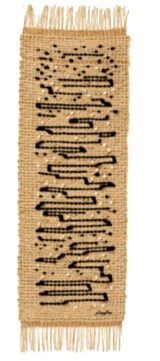
Code, 1962
Code, 1962
Cotton, hemp, metallic thread, and wool
58.4 x 18.4 cm
The Josef and Anni Albers Foundation, Bethany, Connecticut
“Losing sight of the practical purpose need not necessarily be a loss, for the impractical result may turn out to be—art.” Anni Albers, 1947[1]
Anni Albers (Berlin, 1899–Orange, Connecticut, 1994) met the artist Paul Klee, one of the greatest influences on her career, when she attended his classes at the Bauhaus, a revolutionary school of design, art and architecture set up in Weimar (Germany) in 1919 by the architect Walter Gropius. The school had three different locations in the course of its history. In 1925 it moved from Weimar to Dessau, also in Germany, before finally relocating in Berlin. It was during the school’s first years in Weimar that Klee taught a subject for the students of fiber art. From then on Anni Albers felt a special admiration for Klee, describing him as a “genius” owing to his ability to combine the abstract and geometrical with the natural and organic [2]. In his classes, Albers learned to work on a composition structurally, using a language of modular forms organized on a grid according to principles of rotation, color change, repetition, multiplication and division [3]. Besides Klee, Albers’ work was also greatly influenced by the textile traditions of the indigenous American peoples, which she encountered during her trips to Latin America starting in 1933. The artist regarded the textiles made by peoples in Mexico and Peru as “the most impressive example of textile art”. In particular, the Peruvian weavers who use age-old techniques were Albers’ “great masters”. She admired the complexity of the designs, the dazzling colors and the motifs on the tunics of the indigenous Inca, Wari and Tiwanaku people, which bore a great similarity to the type of pattern she had explored at the Bauhaus under Klee’s instruction [4]. She felt a special attraction for the signs of the pre-Columbian cultures, where writing and drawing coincide, and she was also especially interested in Inca tunics, which incorporate a pattern of geometric motifs known in the Quechua language as tocapu.
In 1936, Albers made two pieces which mark the beginning of a new artistic phase: Monte Albán (1936) and Ancient Writing (1936). Here she first used the technique of floating weft, where an additional weft thread is interlaced (“floating”) over the woven surface. With this technique, the artist was able to “draw” lines on the surface of the woven structure. Albers applied the technique in works she called “pictorial weavings”, aiming to show that these fiber pieces should have a status analogous to pictorial art. In this way they would be objects whose meaning and intention were purely aesthetic, with no utilitarian function [5].
The most significant works of the next few decades can be divided into two types. On one side are those which use images derived from the landscapes or ancient motifs of the indigenous American cultures, and on the other those which evoke linguistic characters and systems based on ideographic signs of the ancient world [6]. Albers wanted her works to be read visually. Her interest in semiotics was aroused by a combination of Klee’s teachings at the Bauhaus and her knowledge of pre-Columbian cultures. Many of the titles of these last works have direct linguistic references. In Code (1962), Albers uses a floating weft to simulate words or phrases. When taken together with the title, the lines and dots recall Morse code or some other kind of abbreviated language.
Preguntas
Look at Code (1962). What do you see? Describe the work in detail. What things draw your attention about this piece? Describe the colors it is made with. What sensations do they transmit to you? How would you describe the black lines? Can you distinguish a pattern, in the sense of a repetitive feature?
Albers calls her works “pictorial weavings”. Why do you think she gave them this name? Make a list of the qualities you think a work of art should have to be called in this way. How do you think weaving and the pictorial are related?
In 1965, Albers published her book On Weaving. Reproduced in it are several diagrams which she draws as designs for her textiles. When you visit the exhibition in the Museum, look at the diagrams reproduced. What similarities and differences do you find between them and Code (1962)?
Albers wanted her works to be read visually. She claimed that her work, like that of the Andean artists she had studied, had direct linguistic references, since it took weaving as a form of language. What do you think of this idea? Do you think a language can be created through clothmaking? Does Albers’ weaving remind you of any language you know? Why, for example, do you think Albers called one of her works Code (1962)? If you could change the title, what would you like it to be? Give reasons for your answer.
In Code (1962), Albers used a floating weft to simulate words or symbols. Every line is different, and is used expressively with the intention of making it look like a language. Look closely at the different figures created by the artist in the weaving, and imagine they were sounds. Think of the weaving as though it were a musical score, and of the lines as forming a musical language. Imagine every line is a musical “note” in a score and the empty spaces are “silences”. Reflect on the importance of silences in a melody, and what you think is the value of blank spaces in a work of art. How do you think the work would sound?
